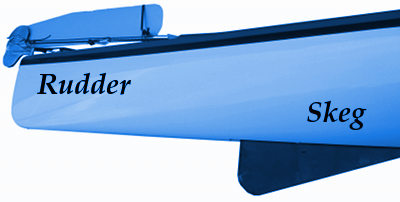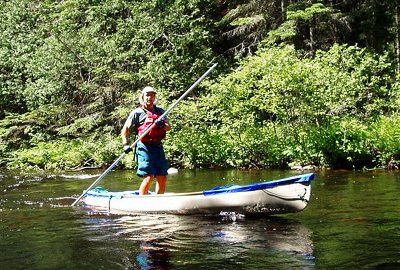Star awards
The BCU Star Awards were a set of personal development awards designed to indicate a persons ability in a canoe or kayak. They have now been replaced by updated Personal Skills awards.
One Star
An introductory personal skill award indicating very basic ability.
A flat water award reflecting basic boat control that can be done in a kayak and/or open boat (canadian canoe).
The first star award reflects the level of skill that people would typically reach after a 6 hour introductory course, e.g. one full day on the water or a six week evening course.
BCU One Star Personal Skills Award
Euro Paddle Pass Level One - Yellow Paddle
Notes
- Try to use different types of boat
- When using an open boat (canadian canoe) learn to paddle on both sides, without switching
- When using a double sea kayak or an open boat with two people, try both front and back
Technical Ability
- Lifting, carrying and launching
- Forward paddling, reverse paddling and stopping
- Maintain an active posture
- Turning using sweep strokes, looking where you are going
- Paddle straight courses and figure-of-8 courses
- Moving the craft sideways using the classic draw stroke
- Keeping the craft straight using the stern rudder
- Preventing a capsize using a low support stroke
- Returning to the bank or beach and disembarking
Safety
- Capsize drill – swim ashore; retain equipment; empty; (assisted) re-entry
- Personal Protective Equipment
- How to use a buoyancy aid and helmet
- The basics of a kayak and paddle
- Appropriate personal clothing – windproof & waterproof clothes
- Water Confidence
Two Star
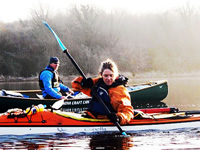
Awarded to recognise a good set of foundation skills.
A flat water award covering a range of kayak and open boat (canoe) skills.
This award must be assessed in both a kayak and canoe. It should be assessed in more than one location, e.g. a river and the sea, and the padddler must have taken part in more than one club event. Consequently it demonstrates a broad set of skills in controlling a variety of craft in sheltered conditions.
BCU Two Star Personal Skills Award
Euro Paddle Pass Level Two - Green Paddle
Notes
- Paddlers must use more than one type of boat
- When using an open boat (canadian canoe) learn to paddle on both sides, without switching
- When using a double sea kayak or an open boat with two people, try both front and back
Technical Ability
- Lifting, carrying and launching
- Forward paddling, reverse paddling and stopping
- Maintain an active posture and good body rotation
- Using the power of the torso
- Appropriate trim
- Steering a kayak
- Sweep strokes
- Low brace turn
- Beginning edging
- Stern rudder
- Bow rudder
- Steering an open boat
- One-quarter sweep strokes
- J strokes
- Outside pivot turn
- C strokes
- Beginning edging
- Paddle straight courses and figure-of-8 courses
- Draw strokes and moving the craft sideways
- Classic draw stroke
- Sculling draw
- Stern rudder and keeping the craft straight
- Support strokes and preventing a capsize
- Low brace / low support stroke
- Sculling for support
- High brace / high support stroke
- Returning to the bank or beach and disembarking
- Securing kayaks and canoes to trailers and roof racks
Safety
- Capsize drill – swim ashore; retain equipment; empty; (assisted) re-entry
- Eskimo rescue, bow presentation and paddle presentation
- Peer rescue via X-Rescue, curl, or tow to shore
- Personal Protective Equipment
- Buoyancy aid, helmet and spray deck
- Kayak and paddle
- Personal clothing – windproof & waterproof clothes
- Water Confidence
Three Star
A boat specific award reflecting a high degree of personal competence.
The paddler should be able to evidince at least 3 club outings of at least 3 hours in the discipline being assessed, and experience of club outings in other disciplines.
There are 5 separate awards at this level, each of which must be assessed and awarded separately.
BCU Three Star Personal Skills Award
Euro Paddle Pass Level Three - Blue Paddle
Touring
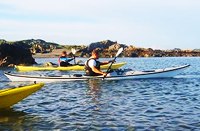
An efficient paddling stroke demonstrating reliance on torso rather than arms to enable a larger distance to be traveled. Capable of adjusting the trim of their boat in response to the load carried and the prevailing conditions, with winds no more than Force 3. The paddler should have experience of at least 6 club events in more than one sea location and a river with grade 2 sections.
White Water
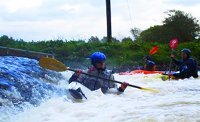
Capable in grade 2 rivers, as part of a led group, able to catch eddies when paddling down a rapid, and paddle upstream in grade 1 conditions.
Open Boat (Canoe)
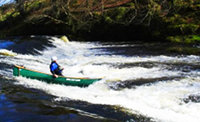
Demonstrating a fluent J-stroke, poling and sailing. Capable of paddling fluently on rivers and lakes, adjusting the boat’s trim, as part of a led group, with winds no more than Force 3.
3 Star Sea Kayak
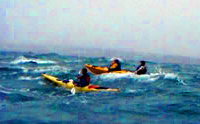
The level of skill, understanding and knowledge demonstrated is of the standard of an able improving sea paddler. Capable in a moderate tidal environment, as part of a led group, with winds no more than Force 4.
3 Star Surf Kayak
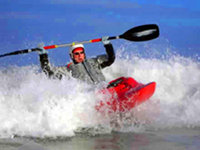
Equipped with the ability to move their boat with control in the surf, not surfing straight at the beach.Surfs the waves rather than being surfed. Uses dynamic body movement. Engages rails. Demonstrates S-curve transitions and the ability to exit the wave at any point.
Requirements
Technical Ability
- Lifting, carrying and launching
- Forward paddling, reverse paddling and stopping
- Maintain an active posture and good body rotation
- Using the power of the torso, cycling action with legs
- Keeping the arms in the safety box
- Appropriate trim
- Steering a kayak
- Sweep strokes
- Low brace turn
- Beginning edging
- Stern rudder
- Bow rudder
- Steering an open boat
- One-quarter sweep strokes
- J strokes on and off the gunnel
- Outside pivot turn
- C strokes
- Beginning edging
- Poling
- Sailing
- Paddle straight courses and figure-of-8 courses, forward and reverse
- S-transitions in surf or in a current
- Draw strokes and moving the craft sideways
- Classic draw stroke
- Sculling draw
- Draw-on-the-move
- Hanging draw
- Stern rudder and keeping the craft straight
- Ferry gliding across a current
- Surfing a wave
- Support strokes and preventing a capsize
- Low brace support stroke
- Sculling for support
- High support stroke
- Paddling into and out of stoppers
- Eskimo roll
- Breaking-in and breaking-out of the current
- Returning to the bank or beach and disembarking
- Securing kayaks and canoes to trailers and roof racks
Safety
- Capsize drill – swim ashore; retain equipment; empty; (assisted) re-entry
- Eskimo rescue, bow presentation and paddle presentation
- Deep water peer rescue via X-Rescue, curl, or tow to shore
- Personal Protective Equipment
- Buoyancy aid, helmet and spray deck
- Kayak or open boat fitted with suitable buoyancy, and paddle
- Personal clothing – windproof & waterproof clothes
- Knife, whistle, two-line, first aid kit, repair kit
- Spare clothing, food and drink
- Exposure bag or emergency shelter
- Water confidence
- Use of throw-lines
- Towing – push & pull contact tow; use of tow-lines, incl. emergency release
- Etiquette – particularly surfing, and in rapids
- Swimming in a current
- Group awareness
Theory
- The effects of wind, tide, swell, geographical features
- Coastguard rescue services
- Potential hazards
- Access
- Map reading, tide tables
- Weather forecasts
- The difference between a skeg and a rudder
Four Star Leader
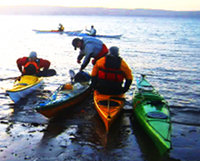
Recognises the ability to lead a group of 4 paddlers in appropriate locations, in up to moderate conditions. As with the 3 star award, there are 5 separate awards at this level, each of which must be assessed and awarded separately.
The paddler will personally be comfortable on grade 3 rivers, or moderate Force 4 conditions, confidently demonstrating a high level of boat control, and qualified to lead a group of 4 other paddlers in trips where they would ideally encounter no more than grade 2 water.
The 4 star leader award is aimed squarely at skilled amateur paddlers in clubs and societies, rather than professionals working for outdoor pursuits companies, where the cost of attaining and keeping professional coaching qualifications up to date can be prohibitive. Capable of planning trips, assessing and managing risk, ensuring the group safety, and acting as team leader when rescuing is required. Demonstrates good group awareness and control.
4 star leaders are required to have safety & rescue and first aid qualifications in addition to personal skills in group leadership.
Safety & Rescue
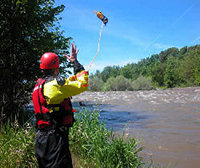
This award concentrates on how to keep yourself and others safe when paddling. It is an extensive safety qualification covering risk awareness and management, individual and group safety, use of safety equipment, and in-water rescues.
It introduces the principle of CLAP : communication, line of sight, avoidance, position of most usefulness.
Important principles introduced are
- Rescue – self, team, victim, equipment
- Rescue – shout, reach, throw, row, wade, swim
- Use of tow lines and throw lines
- Clean Rope – no loops or knots; and if you carry a rope, carry a knife
Rescue & Emergency Care First Aid
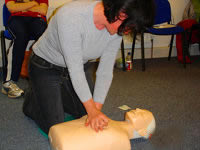
This award concentrates on how to act as a first responder to a casualty, and covers basic first aid including CPR.
Important principles introduced are
- Danger – check for dangers
- Response – is the casualty concious
- Airway – clear and open the airway
- Breathing – check for unaided breathing
- Circulation – check for bleeding
- Deformity – check for breaks and swelling
- Emotion – provide emotional support
Coaching
Level 1 Coach
The level 1 award is the entry level coaching award. Level 1 coaches can operate alone in very sheltered water environments with groups of up to 8 paddlers, only if a supervising coach has provided session guidance and task cards for the level 1 coach to follow.
A level 1 coach can manage an indoor or outdoor pool session.
Level 1 coaches with the 4* Leader personal skills award can take small groups onto flat water, introduce them to kayaking and canoeing, then take them on short trips in moderate water environments such as the rapids at Shaw’s Bridge.
Level 2 Coach
A level 2 coach is able to deliver a series of canoe and kayak sessions safely and efficiently in a sheltered water environment.
The course is aimed at Level 1 coaches who feel they are ready to further develop their coaching skills so that they can deliver sessions independently of other coaches.
A level 2 coach is a professional coach recognised and qualified to coach at any outdoor pursuits or paddlesport centre in the United Kingdom, and across Europe.
The level 2 coach can bring students through their first years of development in paddlesports, and can train, assess and award 2 star personal skills qualifications.
Level 3 Coach
A level 3 coach is able to plan, implement and analyse long term development programmes. This is an appropriate level of coach for a person to be in charge of paddlesport activities in a club or centre. It is at this level that coaches begin to become increasingly specialised.
Safety & Rescue

All coaches have safety & rescue qualifications. These are extensive safety qualifications covering risk awareness and management, individual and group safety, use of safety equipment, and in-water rescues.
They are familiar with the principle of CLAP : communication, line of sight, avoidance, position of most usefulness.
Important principles regularly in use are
- Rescue – self, team, victim, equipment
- Rescue – shout, reach, throw, row, wade, swim
- Use of tow lines and throw lines
- Clean Rope – no loops or knots; and if you carry a rope, carry a knife
Rescue & Emergency Care First Aid

This award concentrates on how to act as a first responder to a casualty, and covers basic first aid including CPR.
Important principles introduced are
- Danger – check for dangers
- Response – is the casualty concious
- Airway – clear and open the airway
- Breathing – check for unaided breathing
- Circulation – check for bleeding
- Deformity – check for breaks and swelling
- Emotion – provide emotional support
